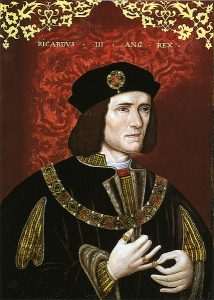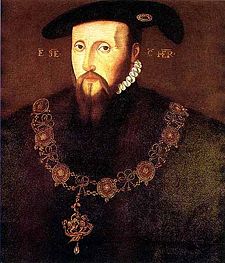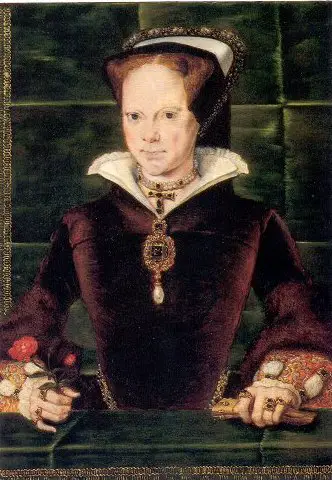 As today is the anniversary of the birth of King Richard III, on 2nd October 1452, I thought I'd share an extract from my book Illustrated Kings and Queens of England and links to Tudor Society resources and further reading on Richard III.
As today is the anniversary of the birth of King Richard III, on 2nd October 1452, I thought I'd share an extract from my book Illustrated Kings and Queens of England and links to Tudor Society resources and further reading on Richard III.
Richard III (1452-1485)
Rule: 1483-1485
Marriages: Anne Neville, daughter of Richard Neville, 16th Earl of Warwick
Issue: Edward of Middleham. 2 illegitimate children: John of Gloucester; Katherine Plantagenet.
Richard III was born on 2 October 1452 at Fotheringhay Castle and was the youngest son of Richard, Duke of York, and Cecily Neville, daughter of the Earl of Westmorland. He became king after deposing his nephew Edward V in June 1483 and was crowned on 6 July 1483 at Westminster Abbey.
In September 1483, Henry Stafford, Duke of Buckingham, led a rebellion against Richard with the intention of deposing him and putting Henry Tudor, Earl of Richmond, on the throne. The rebellion was quashed and Buckingham was executed. However, Henry Tudor, who was in exile in Brittany, landed at Milford Haven, in Wales, on 7 August 1485 with a force made up of his English supporters and French mercenaries.
Richard and his forces met Henry's on 22 August 1485 near Market Bosworth in Leicestershire at the Battle of Bosworth. Although Henry had managed to build an army of around 5,000 men, Richard's men are thought to have numbered around 12,000. Richard must have felt confident that he could squash Henry, particularly when they finally met and Henry's men were struggling to negotiate marshland and Richard's men were on higher ground. Richard and his army certainly had the advantage, particularly as Henry had no battle experience. Richard took the initiative and sent the Duke of Norfolk and some men out to attack Henry's men, who had become strung out in a line below them after being forced to circle around the marsh. Fortunately for Henry, he had the Earl of Oxford, an experienced soldier on his side, who knew just what to do. Oxford quickly created a wedge of men between two banners and, in the fighting that followed, the Duke of Norfolk was killed. Things looked good for the king until the Stanleys, who had been watching events unfold but had not committed their armies to any particular side, made a decision. As Richard III's cavalry clashed with Henry and his men, who had been on their way to appeal to the Stanleys, William Stanley ordered his men to attack the king and his cavalry. Before the Stanleys and their men reached Henry and Richard, Richard's men managed to kill Henry's standard bearer Sir William Brandon, and unhorse Sir John Cheyne, but the tide turned when Stanley's men reached the spot. King Richard III, himself, was killed and Henry Tudor was crowned King Henry VII later that day when Richard's crown was recovered.
Richard was buried in the choir of the Grey Friars monastery. Human remains were found in an archaeological dig in a Leicester car park in 2012 and DNA results proved that “beyond reasonable doubt” the remains were Richard III. The skeleton showed that the King had suffered from a scoliosis of the spine and that a large wound to the base of the skull, probably from a halberd, and a blow from a bladed weapon had killed him. His remains were reinterred at Leicester Cathedral.
Resources and further reading
- Richard III Tudor Life magazine special, March 2015.
- Wars of the Roses and Richard III Primary Sources
- Richard III: The New Evidence Video
- The Search for Richard III Videos
- Expert Talk: Susan Fern on Bosworth’s Lost Commander
- Richard III and the Wars of the Roses online course - Toni Mount, who writes regular articles for Tudor Life magazine has devised an excellent online course on Richard III and the Wars of the Roses and you can find out more at MedievalCourses.com.
- Richard III Quiz
- Richard III: Brother, Protector, King by Chris Skidmore
- Richard III by David Baldwin
- The Mythology of Richard III by John Ashdown-Hill
- The Last Days of Richard III and the Fate of his DNA: The Book that Inspired the Dig by John Ashdown-Hill
- Richard III and the Princes in the Tower by A.J. Pollard
- Richard III and the Murder in the Tower by Peter A. Hancock
- Richard III by Michael Hicks
- Richard III: The Road to Leicester by Amy Licence
- Richard III: The Young King to be by Josephine Wilkinson
- Richard III: From Contemporary Chronicles, Letters and Records by Keith Dockray and P. W. Hammond



How, on earth, did they feed those thousands of soldiers?
With difficulty I expect! They would have had provisions, which were carried with them, and then also lived off the land.
Happy Birthday King Richard.
Happy Birthday, King Richard 111 ~ Hannibal ~
I don’t believe Richard ate or butchered anyone. What a ridiculous comment.